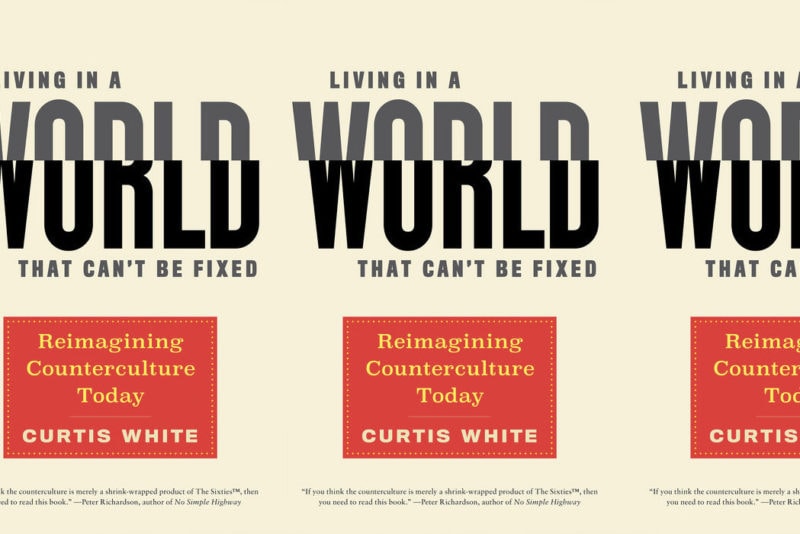It’s hard to think of counterculture as leading rather than rebelling. It plays a vital role in countering norms in any place where norms exist to preserve themselves and the institutions they serve, which, of course, is all places. The status quo is not nefarious so much as it’s inevitable—or maybe it’s both. So it’s not enough for counterculture to rebel. Rather, it should seek to replace a discredited culture with a more humane, sustainable, and less vulgar one. To rebel is to fight back; to replace is to fill a void of meaning with sustainable meaning.
Curtis White calls for a less self-destructive world in Living in a World That Can’t Be Fixed: Reimagining Counterculture Today, a book structured as part polemic, part history, part rant. He starts by elevating the English Romantics as the original counterculture: Shelley was expelled from Oxford for promoting atheism, and Byron lived abroad and fought with the Greeks in their war of independence against the Ottoman Empire.
White argues that Romanticism “was not merely a period in history; it was a social movement first. It was a rebellion against a rigid class system that condemned individuals to specific and limited roles and denied their individual genius…Coleridge was meant to be a clergyman, Keats a surgeon, and Shelley a Peer…What England offered was too limited, and the Romantics wanted something ‘oceanic,’ something ‘with the feeling of the eternal,’ as the French novelist Romain Rollard expressed it in a letter to a skeptical Sigmund Freud.” White’s argument here is compelling, since the Romantics were rebelling against the rationalist strictures of the Enlightenment and the failures of revolutionary ferment in France. The only way out wasn’t reform, tinkering around the edges, mere fighting back, but, rather, replacement of the dominant paradigm.
A couple of problems arise when, after his dalliance with the Romantics, White fast-forwards to more recent times. One is that his tone can have the rawness of an irascible pamphleteer. More of an issue is that early in the book he seems to embrace the notion that economic dispossession is fertile ground for political conmen. This is a strain in American history, White seems to suggest, tracing Nathanael West’s 1939 Day of the Locust to illustrate the idea that disillusioned outsiders become fodder for reactionary movements:
Scattered among these [wealthy] masqueraders were people of a different type. Their clothing was somber and badly cut, bought from mail-order houses. While others moved rapidly, darting into stores and cocktail bars, they loitered on the corners or stood with their backs to the shop windows and stared at everyone who passed. When their stare was returned, their eyes filled with hatred.
While not necessarily entirely wrong, this characterization feels similar to the classic Midwestern-everyman-in-diner trope the New York Times peddles to suggest resentment is purely about economic anxiety. This risks confusing resentment with bad values. In a similar vein, “voting,” White writes, “becomes an expression of the desire for revenge against a world that has humiliated them intellectually, economically, sexually, racially, and through the opulent creations that the left gazes upon from an alien distance, aesthetically.” This is a patronizing view, to my mind, and elides the fact that people could believe bad things and have malevolent intent without being wounded or humiliated by society first.
That aside, what White does well—and what really is the central concept of the entire book—is framing counterculture as the elevation of “impertinence.” By impertinence, he means whatever isn’t practical, respectable, acceptable, or otherwise tedious. It’s in impertinence that meaningful art and community flourish, where sustainable notions of self are free to form and find their way to loosen the bonds of seeming selfhood, and to merge with others. The primary means of impertinence for White is, appropriately, art, as it “meddles in what is beyond the proper sphere…The culture of impertinence intends to seduce its audiences to join in its impertinence.” White goes on to cite as examples Stravinsky’s The Rite of Spring in 1913, the Whiskey a Go Go with Frank Zappa and the Mothers of Invention in 1967, and Pixies’ “Debaser” in 1989.
Each of these artistic events saw an alternative aesthetic, a countercultural replacement, that didn’t rebel against the status quo so much as replaced it with what wasn’t safe, average, or boring. It was impertinence unbound.
White often operates on the well-worn but legitimate binary of art vs. commercialism, in this case, in the service of impertinence. And he’s careful not to “reduce a moral problem to an aesthetic one,” because he’s not arguing for a revolutionary change in taste, but rather a rejection of whatever holds impertinence back from asserting itself. Still, it’s a relief that White’s polemic isn’t oppressively utopian. Counterculture to him is about the assertion of the impractical, improvisational, and unconventional, which are arguably the only ways forward for art and politics.
Despite his grim apprehension of the world, there’s some measured optimism. White asserts that “humans are really good not at knowing but at learning, of being open to new ideas even if that involves a little permanent bewilderment.” He wants people to misbehave, to create something beautiful. But the goal isn’t greatness. Counterculture is about resisting the pressures of money, status, consumption, and stupidity in the service of being human again, creating communities where people are together as themselves, on their own terms, in full embrace of their shared and not shared humanity. It’s complicated and it’s not.
If all this sounds grandiose or cloyingly idealistic, maybe it is. Then again, White cites the poet Mary Sarton, who wrote: “one must think like a hero to behave like a merely decent human being.”

